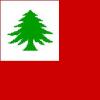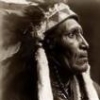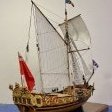-
Posts
1,222 -
Joined
-
Last visited
Reputation Activity
-
 jbshan got a reaction from janos in HMS Royal William by KeithW - Euromodel - 1/72
jbshan got a reaction from janos in HMS Royal William by KeithW - Euromodel - 1/72
This model is in the collection of the US Navy Academy. Hope it helps.
http://nauticalhistory.weebly.com/100-gun-royal-william-of-1719.html
Joel Sanborn
-
 jbshan got a reaction from lb0190 in GUNBOAT PHILADELPHIA by Steve.Y - FINISHED - Model Shipways
jbshan got a reaction from lb0190 in GUNBOAT PHILADELPHIA by Steve.Y - FINISHED - Model Shipways
Here are the 9-pounders:
I still have to add the 'jewelry', eyebolts and ringbolts and retainer chain. I'm not sure the sizes laid out by the kit are correct, they seem a bit thin.
Joel Sanborn
-
 jbshan got a reaction from bebopsteve in GUNBOAT PHILADELPHIA by Steve.Y - FINISHED - Model Shipways
jbshan got a reaction from bebopsteve in GUNBOAT PHILADELPHIA by Steve.Y - FINISHED - Model Shipways
Here are the 9-pounders:
I still have to add the 'jewelry', eyebolts and ringbolts and retainer chain. I'm not sure the sizes laid out by the kit are correct, they seem a bit thin.
Joel Sanborn
-
 jbshan got a reaction from Piet in Muscongus Bay Lobster Smack by Piet - FINISHED - Midwest Products - length 15"
jbshan got a reaction from Piet in Muscongus Bay Lobster Smack by Piet - FINISHED - Midwest Products - length 15"
Don't know if this will blow up enough to help any...
I like a more subdued color palette, by the way.
I used acrylic artist's colors, matte medium on the sails. The darker color on them is from age/dust.
This is a pretty vessel; I liken it to a gull sitting on the water.
Joel Sanborn
-
 jbshan got a reaction from egkb in Muscongus Bay Lobster Smack by Piet - FINISHED - Midwest Products - length 15"
jbshan got a reaction from egkb in Muscongus Bay Lobster Smack by Piet - FINISHED - Midwest Products - length 15"
Don't know if this will blow up enough to help any...
I like a more subdued color palette, by the way.
I used acrylic artist's colors, matte medium on the sails. The darker color on them is from age/dust.
This is a pretty vessel; I liken it to a gull sitting on the water.
Joel Sanborn
-
 jbshan got a reaction from Chuck Seiler in GUNBOAT PHILADELPHIA by Steve.Y - FINISHED - Model Shipways
jbshan got a reaction from Chuck Seiler in GUNBOAT PHILADELPHIA by Steve.Y - FINISHED - Model Shipways
Here are the 9-pounders:
I still have to add the 'jewelry', eyebolts and ringbolts and retainer chain. I'm not sure the sizes laid out by the kit are correct, they seem a bit thin.
Joel Sanborn
-
 jbshan got a reaction from GLakie in Muscongus Bay Lobster Smack by Piet - FINISHED - Midwest Products - length 15"
jbshan got a reaction from GLakie in Muscongus Bay Lobster Smack by Piet - FINISHED - Midwest Products - length 15"
Don't know if this will blow up enough to help any...
I like a more subdued color palette, by the way.
I used acrylic artist's colors, matte medium on the sails. The darker color on them is from age/dust.
This is a pretty vessel; I liken it to a gull sitting on the water.
Joel Sanborn
-
 jbshan got a reaction from texxn5 in Niagara by lb0190 - Model Shipways - 1/64
jbshan got a reaction from texxn5 in Niagara by lb0190 - Model Shipways - 1/64
That apparently was characteristic of USN brigs and may well have led to a greater-than-normal casualty rate.
Niagara is reported to have 'walked away from' the 'Tall Ship' fleet when she accompanied them on the first leg of their return to Europe one year. Calm seas and light winds. She's a thoroughbred.
-
 jbshan got a reaction from catopower in English Flags on a Launching
jbshan got a reaction from catopower in English Flags on a Launching
Well, there might be up to nine ships that needed a full suit of flags. This is in the second half of the1600s. There was a full admiral commanding each of three squadrons, an admiral of the fleet who flew the red ensign, a vice admiral with white and a rear admiral with blue. Each of those three had two subordinates commanding portions of each squadron. The fleet might be up to 80 or more ships, so it was hard to get the signals propagated to all the ships in line.
Yes, each fighting season the Admiral would issue his orders and signals, usually based on those that had been used before, and these morphed into the fighting instructions.
Very nice pic, thank you, Tadeusz.
I'll have to look around, I'm sure I have a pic in some book of a smaller, one or two masted vessel being launched.
Joel Sanborn
-

-
 jbshan got a reaction from Chuck Seiler in Continental Gunboat PHILADELPHIA by Chuck Seiler - Model Shipways - 1:24 Scale - Enhanced
jbshan got a reaction from Chuck Seiler in Continental Gunboat PHILADELPHIA by Chuck Seiler - Model Shipways - 1:24 Scale - Enhanced
http://uvsmgshipmodelguild.wikispaces.com/Philadelphia+of+1776
A couple of pics of my Philadelphia planking. I used a mechanical pencil with constant diameter lead. The scale is so large I think the blandness of the basswood needs something to keep it interesting. I'm not sure if I'll do the same with the interior plank, but almost certainly will do the deck plank the same way.
At the bottom are guns, Floquil Engine Black for tthe barrels and other hardware.
Pic below also.
The Smithsonian has done a 3D scan of the Philadelphia, very interesting. You can drag with your mouse, expand/contract with the scroll wheel, and there is a measuring tape feature.
http://3d.si.edu/explorer?modelid=47
Joel Sanborn
-
 jbshan got a reaction from bebopsteve in Continental Gunboat PHILADELPHIA by Chuck Seiler - Model Shipways - 1:24 Scale - Enhanced
jbshan got a reaction from bebopsteve in Continental Gunboat PHILADELPHIA by Chuck Seiler - Model Shipways - 1:24 Scale - Enhanced
http://uvsmgshipmodelguild.wikispaces.com/Philadelphia+of+1776
A couple of pics of my Philadelphia planking. I used a mechanical pencil with constant diameter lead. The scale is so large I think the blandness of the basswood needs something to keep it interesting. I'm not sure if I'll do the same with the interior plank, but almost certainly will do the deck plank the same way.
At the bottom are guns, Floquil Engine Black for tthe barrels and other hardware.
Pic below also.
The Smithsonian has done a 3D scan of the Philadelphia, very interesting. You can drag with your mouse, expand/contract with the scroll wheel, and there is a measuring tape feature.
http://3d.si.edu/explorer?modelid=47
Joel Sanborn
-
 jbshan got a reaction from mtaylor in 1760's Royal Navy deck planking and waterway nibbing patterns?
jbshan got a reaction from mtaylor in 1760's Royal Navy deck planking and waterway nibbing patterns?
Consarn it! The more I learn, the more work I seem to lay out for myself. :-)
That looks tougher than doing it the easy way, Chuck. I thought I was doing good just making the linings.
Thanks again.
Joel Sanborn
-
 jbshan got a reaction from paulsutcliffe in English Flags on a Launching
jbshan got a reaction from paulsutcliffe in English Flags on a Launching
Originally, the Standard was flown as the command flag of the Lord High Admiral and could also be used as a signal flag. Queen Anne reserved its use to herself. Edward VII restricted its use everywhere to himself, as it is now.
If flown at a launching it could represent either the Sovereign or the Lord High Admiral, ante 1702. The ship would become the property of the Admiralty upon launch, so the Admiralty or Lord High Admiral could be represented by the Standard as well as the Admiralty flag.
Launches are ceremonial occasions and ships might be decorated with everything in the flag locker. 500 paintings and Van de Veldt drawings can't all be wrong.
Yes, 1/1/01 (1801 that is) marks the change to the current Union Flag including Ireland and the St. Patrick cross. We must always be careful of the date as many things have changed over the last 500-1000 years, practices, vocabulary and regulations included. Prior to the 1860s when the White Ensign was reserved to the Navy, the default ensign would have been red, white being only a squadronal color.
Small ships, well, less masts so who knows until we find a picture.
-
 jbshan got a reaction from mtaylor in English Flags on a Launching
jbshan got a reaction from mtaylor in English Flags on a Launching
Flag officers would have pendants and ensigns, as rank flags. 'The Standard' refers to the Royal Standard. The Duke of Clarence, or whoever, might fly his own, on his own ship, but that would probably be called 'His Royal Highness' Flag' and in any event not make it into the general signal book as there probably wouldn't be many ships carrying that flag, maybe only one, whereas the Royal Standard would be part of a full set of flags and signals. The difference between the two is only a band with labels and not discernible from a distance. Other lesser personages would have had to satisfy themselves with a normal rank flag.
Remember, too, that we are talking a very large piece of sewing here, perhaps 20 by 30 or more feet. Most people would not have such a large thing just hanging about to take out to sea with them, and certainly not copies for signaling.
Joel Sanborn
-
 jbshan got a reaction from druxey in English Flags on a Launching
jbshan got a reaction from druxey in English Flags on a Launching
Flag officers would have pendants and ensigns, as rank flags. 'The Standard' refers to the Royal Standard. The Duke of Clarence, or whoever, might fly his own, on his own ship, but that would probably be called 'His Royal Highness' Flag' and in any event not make it into the general signal book as there probably wouldn't be many ships carrying that flag, maybe only one, whereas the Royal Standard would be part of a full set of flags and signals. The difference between the two is only a band with labels and not discernible from a distance. Other lesser personages would have had to satisfy themselves with a normal rank flag.
Remember, too, that we are talking a very large piece of sewing here, perhaps 20 by 30 or more feet. Most people would not have such a large thing just hanging about to take out to sea with them, and certainly not copies for signaling.
Joel Sanborn
-
 jbshan got a reaction from jchbeiner in English Flags on a Launching
jbshan got a reaction from jchbeiner in English Flags on a Launching
The best documented source I have is an illustration in 'Naval Warfare in the Age of Sail', Brian Tunstall, p. 44. It is four pages from 'Instructions for the better Ordering his Majesties Fleet, no date (c1688) MOD'
One of the pages shows 'Signalls by which the Generall calls the Capitall Officers &c. on board his Ship.' The third signal is 'If ye Standard be put in ye same place [that is in the mizzen shrouds] then ye Flags Officers only are to repair on Board.' It's pretty small and cursive and the spelling is strange to my eye, but that's the gist of it. The title page is stamped 'Admiralty Office Library'.
Another (p 41) is a page from 'AN INDEX OF THE SIGNALS CONTAINED IN THE INSTRUCTIONS for SAYLING.' This is variously dated, part printed under James II, part under William and Mary, so 1688-1689.
Just as an example, 'SIGNALS with One Gun. From the Admiral. #3 One Gun, and a Union Flag, or Ensign, or Standard, or a Red Flag, or a White Flag, or a Blew Flag, put in the Miffen-Shrouds........ Page 5 Letter 8' NMM, SIG/A/5 and 6
Apparently you would read the signal, go to the correct page, and would learn what one gun and a standard in the Mizzen shrouds meant you to do.
Remember, times change.
Joel Sanborn
-
 jbshan got a reaction from lb0190 in Niagara by lb0190 - Model Shipways - 1/64
jbshan got a reaction from lb0190 in Niagara by lb0190 - Model Shipways - 1/64
That apparently was characteristic of USN brigs and may well have led to a greater-than-normal casualty rate.
Niagara is reported to have 'walked away from' the 'Tall Ship' fleet when she accompanied them on the first leg of their return to Europe one year. Calm seas and light winds. She's a thoroughbred.
-
 jbshan got a reaction from augie in Niagara by lb0190 - Model Shipways - 1/64
jbshan got a reaction from augie in Niagara by lb0190 - Model Shipways - 1/64
That apparently was characteristic of USN brigs and may well have led to a greater-than-normal casualty rate.
Niagara is reported to have 'walked away from' the 'Tall Ship' fleet when she accompanied them on the first leg of their return to Europe one year. Calm seas and light winds. She's a thoroughbred.
-
 jbshan got a reaction from catopower in English Flags on a Launching
jbshan got a reaction from catopower in English Flags on a Launching
Originally, the Standard was flown as the command flag of the Lord High Admiral and could also be used as a signal flag. Queen Anne reserved its use to herself. Edward VII restricted its use everywhere to himself, as it is now.
If flown at a launching it could represent either the Sovereign or the Lord High Admiral, ante 1702. The ship would become the property of the Admiralty upon launch, so the Admiralty or Lord High Admiral could be represented by the Standard as well as the Admiralty flag.
Launches are ceremonial occasions and ships might be decorated with everything in the flag locker. 500 paintings and Van de Veldt drawings can't all be wrong.
Yes, 1/1/01 (1801 that is) marks the change to the current Union Flag including Ireland and the St. Patrick cross. We must always be careful of the date as many things have changed over the last 500-1000 years, practices, vocabulary and regulations included. Prior to the 1860s when the White Ensign was reserved to the Navy, the default ensign would have been red, white being only a squadronal color.
Small ships, well, less masts so who knows until we find a picture.
-
 jbshan got a reaction from jchbeiner in English Flags on a Launching
jbshan got a reaction from jchbeiner in English Flags on a Launching
In 'Restoration Warship' Richard Ensor, author and illustrator, shows Lenox at launch with, in order, Jack, Lord High Admiral, Royal Standard, Union Flag and Red Ensign at ensign staff. He says it is based on a period source. Additionally, there is a detail shown from 'A Geometric Plan of Deptford Dockyard', Thomas Milton, 1753 with the flags in the same order. This may be a standard arrangement. A vessel with fewer masts might leave off the Union Flag, then perhaps the Lord High Admiral's flag for a single masted vessel.
In the case of Lenox, Charles II was present, but I have read that it was presumed in all cases that the Sovereign was present at the launch of one of his ships so his Standard was flown. The precedence of the flags would not be altered, in my opinion.
In preperation for the launch of Lenox, arrangement was made for poles to be stepped in the mast locations, presumably from yard stocks, to which they could be returned when the ceremonies were concluded.
As to size, the largest ensign a ship carried would be equal to the ship's beam in the fly, so Lenox's would be in the neighborhood of 40 feet in the fly. The Jack was equal to the union of the Ensign, so perhaps 20 feet in the fly. Royal Standards, Lord High Admiral, etc. would be the same as Ensigns. Flags were sized by 'breadths', the width of the fabric as it came from the loom, which I must do further research on. There were only standard sizes stocked, so the correspondence between ship's beam and flag size would be approximate.
Ships were issued flags and signals from the dockyard, so, again, as with the poles, they would have come from stock to which they could be returned, and the largest sizes could be used whatever the ship will eventually be issued.
Lenox at launch, Ensor's painting:
Joel Sanborn
-
 jbshan got a reaction from mtaylor in English Flags on a Launching
jbshan got a reaction from mtaylor in English Flags on a Launching
In 'Restoration Warship' Richard Ensor, author and illustrator, shows Lenox at launch with, in order, Jack, Lord High Admiral, Royal Standard, Union Flag and Red Ensign at ensign staff. He says it is based on a period source. Additionally, there is a detail shown from 'A Geometric Plan of Deptford Dockyard', Thomas Milton, 1753 with the flags in the same order. This may be a standard arrangement. A vessel with fewer masts might leave off the Union Flag, then perhaps the Lord High Admiral's flag for a single masted vessel.
In the case of Lenox, Charles II was present, but I have read that it was presumed in all cases that the Sovereign was present at the launch of one of his ships so his Standard was flown. The precedence of the flags would not be altered, in my opinion.
In preperation for the launch of Lenox, arrangement was made for poles to be stepped in the mast locations, presumably from yard stocks, to which they could be returned when the ceremonies were concluded.
As to size, the largest ensign a ship carried would be equal to the ship's beam in the fly, so Lenox's would be in the neighborhood of 40 feet in the fly. The Jack was equal to the union of the Ensign, so perhaps 20 feet in the fly. Royal Standards, Lord High Admiral, etc. would be the same as Ensigns. Flags were sized by 'breadths', the width of the fabric as it came from the loom, which I must do further research on. There were only standard sizes stocked, so the correspondence between ship's beam and flag size would be approximate.
Ships were issued flags and signals from the dockyard, so, again, as with the poles, they would have come from stock to which they could be returned, and the largest sizes could be used whatever the ship will eventually be issued.
Lenox at launch, Ensor's painting:
Joel Sanborn














